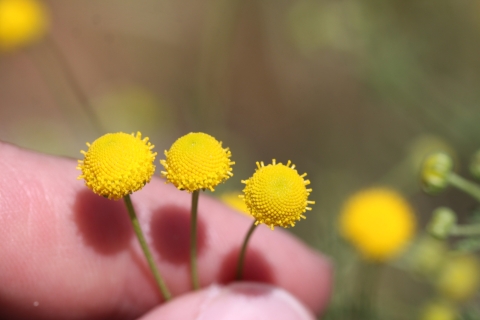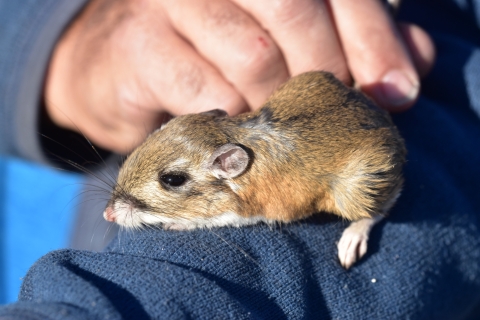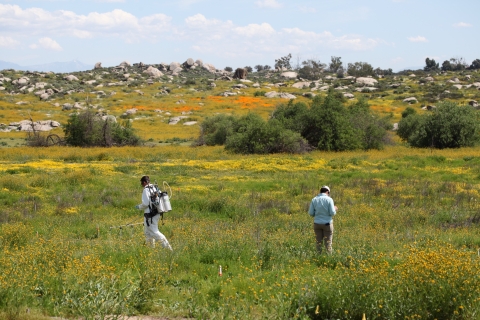A field of yellow, ball-shaped flowers beckons. It’s pretty to look at and one is tempted to walk through it expecting to inhale a pleasing aroma. Not so fast! Oncosiphon piluliferum, known by the more appropriate moniker stinknet, has an odor reminiscent of turpentine. “The smell is so overwhelming it can give you a headache,” according to Brian Shomo, director of Natural Resources with the Riverside County Habitat Conservation Agency.
“Introduced to California in the 1980s, this invasive plant from South Africa poses a growing risk to native plants and animals in Southern California, including the federally endangered Stephens’ kangaroo rat,” said Karin Cleary-Rose, division chief at the U.S. Fish and Wildlife Service’s Palm Springs Office.
Stinknet grows in dense mats and excludes all other native plants. Loralee Larios, assistant professor at the University of California, Riverside’s Botany and Plant Sciences Department, oversees research on the impact of stinknet on the Stephens’ kangaroo rat and experiments to determine the most effective methods of eradicating this invasive species invasive species
An invasive species is any plant or animal that has spread or been introduced into a new area where they are, or could, cause harm to the environment, economy, or human, animal, or plant health. Their unwelcome presence can destroy ecosystems and cost millions of dollars.
Learn more about invasive species .
Efforts to eradicate stinknet are costly and time consuming. Prescribed burning has not shown a positive effect on control of the plant, and herbicides have variable rates of success, according to Larios. “Roundup can take 2–3 weeks to show a plant response,” she said. “However, if applied early enough in the season, it can show positive results in suppressing the plants.”
The plant offers low value nutrition and is avoided by most species. Within the 8,800-acre Lake Perris State Recreation Area, more than 700 acres are heavily infested with stinknet, including habitat used by the kangaroo rat. Preliminary trapping efforts conducted to determine the health of the kangaroo rat population in that area show a decline body weight of individuals. Shomo noted that across the species’ range, Stephens’ kangaroo rats weigh about 70 grams on average. In contrast, the kangaroo rats at Lake Perris typically weigh notably less, around 60 grams. “It’s like eating iceberg lettuce exclusively,” said Shomo. “It keeps you alive, but you might not be very healthy.” The concern is how the low body weight could affect that population’s reproductive success.
Unfortunately, removal of stinknet does not result in restoration of native plant communities. “We’re not seeing a huge response in native plants,” said Larios. That may be bad news for the kangaroo rats. Larios said, “kangaroo rats in areas with low native plant cover may consume those seeds at a higher rate, leaving a smaller seedbank over time.” This means the animals unknowingly may leave themselves without enough native plants to sustain their population.
“If we don’t take care of stinknet now, it will be uncontrollable,” says Shomo.
The best way to keep habitat healthy for Stephens’ kangaroo rats and other species is to keep this invasive plant from taking hold. “We appreciate the public’s help in stopping the spread of stinknet and other non-native, invasive plants across the landscape in Southern California,” said Cleary-Rose.
How you can help prevent, detect and report the spread of stinknet:
- Don’t be a spreader. If you have visited an area infested with stinknet, change your clothing before visiting any other natural areas. Stinknet seeds are extremely small and are easily carried on shoes and fabric, and in animal fur. A stiff brush can be used to wipe the bottoms of shoes and remove any embedded seeds.
- Be a reporter. If you see a stinknet plant, take a photo, note the GPS coordinates and upload the information to iNaturalist — https://www.inaturalist.org/
- Be a puller. If you see a stinknet plant pop up along a trail, go ahead and pull it out by the roots and throw it in the trash.






